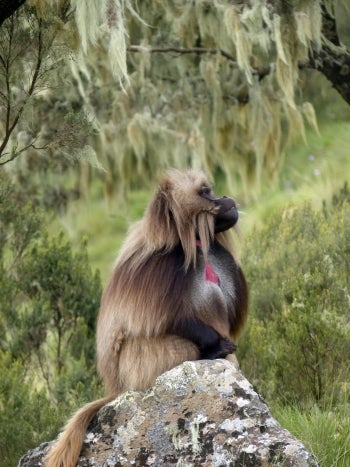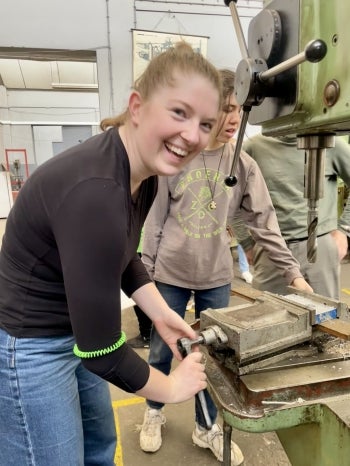Student engineers travel to Ethiopia this summer to help protect local wildlife

Students from ASU and Addis Ababa Institute of Technology work on building machines that can reduce plastic waste in Ethiopia. Photo courtesy of India Schneider-Crease
The jagged peaks in Ethiopia’s Simien Mountains National Park are home to the rare gelada monkey. It is the only place in the entire world where the endangered animals — nicknamed the “bleeding-heart monkey” for the special splash of red color that covers their chest — can be found.
The terrain in the mountain range is rugged, with high plateaus, dramatic cliffs and deep drops. Over time, the once pristine park has been polluted by hundreds of thousands of plastic water bottles discarded by tourists each year, which are then picked up by the primates.
That’s what drew India Schneider-Crease, Tyler Eglen and the Arizona State University chapter of Engineers Without Borders to Ethiopia this summer.
Schneider-Crease is co-director of the Simien Mountains Gelada Research Project and Eglen is a project manager at ASU’s Circular Living Lab. They took a team of nine ASU students for a two-week journey to the African nation to tackle the plastic problem, which threatens the lives of not only the monkeys but other rare species, including Ethiopian wolves and walia ibex (wild goats).
“Our ultimate goal is to protect the area’s fragile ecosystem and endangered and endemic wildlife while providing pathways for local residents to profit from those ecosystems,” said Schneider-Crease, assistant professor in the School of Human Evolution and Social Change. “We have been building up to this since we started the project in 2020.”
Schneider-Crease, an evolutionary anthropologist, has spent more than a decade studying the gelada monkeys at a long-term field site in the national park. She leads the plastic recycling student-driven project in the area.
The ASU contingency worked with the Addis Ababa Institute of Technology and Gizish Industries in Ethiopia to build technology to address the area’s plastic problem and sustainable partnerships with the Ethiopian community.
The long-term plan is to take the plastic bottles discarded by travelers and transform them into products that the community can buy and sell to tourists, and eventually the local market, for profit.
This trip was the first step toward that goal.
Making the machines
The team arrived in Addis Ababa, the country’s capital, and set out to build two customized machines that they had been prototyping for the past two years at ASU — machines that would work within the electricity parameters and supply availability of the Ethiopian community.
One of the machines was designed to shred the plastic gathered from the park and the other was an injection molder made to take shards of plastic, heat them into liquid and transform them into marketable products for tourists.
The students put in long hours, facing and overcoming many obstacles.
Kaleb Tefera, an Ethiopian-born computer science student from the Ira A. Fulton Schools of Engineering, was responsible for securing locally sourced materials needed to build the machines.
“That was pretty intense,” he said. “It’s not like we had an Amazon where we could go and order everything. I had to find the vendors, argue to get the materials we needed and then get back to the shop where everyone was waiting for me.”
Once they had the materials, there were other difficulties. Limited tools and power outages coupled with the inherent challenges of metalworking (metal cutting, machining and welding) posed formidable obstacles to their progress.
“They have tools and machines that are very different from what we use in Arizona,” said Kathleen Myers-Haeussler, who recently earned a bachelor's degree in environmental engineering from the Fulton Schools and is now working toward a master’s degree in civil, environmental and sustainable engineering at ASU.
Myers-Haeussler said that at one point, they were missing a tiny piece needed to make one of the machines run.
“We basically had to recreate it,” Myers-Haeussler said. “So that was a bit of a challenge. But at the same time, that's what engineering is all about — finding creative ways to get past the problem.”
As time went on, the students became more acclimated to the machines and processes involved and gradually built the technical skills necessary to finish the job.
Eglen said that the opportunities provided by the trip were unlike anything the students could experience during standard undergraduate engineering classes.
"What do you do when the real world presents you with very complex problems that can’t be predicted from the comfort of a classroom?" said Eglen, who served as the student mentor for the trip. "You engineer new solutions. And that’s exactly what the students were tasked to do. They grew and developed as engineers by working with their hands and minds to create these plastic recycling machines alongside local engineers and students from Addis."
Beyond an engineering education
The experience in Ethiopia was educational for the students from a cultural standpoint as well.
They enjoyed Ethiopian coffee and tried regional foods such as doro wat (a spicy chicken stew), kitfo (minced raw beef) and shiro wat (a curry made from dried chickpeas). They also learned how to count to 10 in Amharic and say hello — “selam.”
The group visited the National Museum of Ethiopia where the 3.2-million-year-old fossil skeleton of LucyThe Lucy skeleton, which provided the first documented proof that our human ancestors walked upright on two feet at least as early as 3.2 million years ago, was discovered by current ASU Professor Donald Johanson in 1974. is stored and learned about both the ancient history of Ethiopia and current conflicts that continue in the country.
“It has been interesting to walk around the areas and see how different their cultures are,” Myers-Haeussler said.
The countdown
The students also faced setbacks during the building process that put them behind schedule. But they learned to be resilient and adaptable.
“The entire time we were unsure that we were going to finish it,” said Nicholas Antrasian, a chemical engineering student at ASU’s Fulton Schools.
The night before they left, they worked on the machines by the light of their cellphones.
On their final Friday afternoon in Ethiopia, the machines were still not working — and the clock was ticking. With just minutes to leave for the airport, the group was under pressure.
“It was very nerve-wracking,” Antrasian said.
And then, with the turn of a switch, the machines were running and the ASU team cheered, exchanged enthusiastic high fives and snapped photos before rushing out of the shop and heading for the airport.
“That was a big moment for all of us,” Tefera said.
“We finished right under the wire,” Schneider-Crease said. “And that was what made it feel exciting.”
Antrasian said he appreciates the opportunities that ASU makes available to students.
“It was definitely very exciting,” he said. “And a very educational and enriching experience.”
Organizers plan to return to Ethiopia next year where more engineering students can continue to work on the project.
The collaborations between the ASU and Ethiopian student engineers were also of great value. Although the two cohorts had previously spoken on the phone, they never met.
“That was really awesome,” Schneider-Crease said. “They started to forge these friendships with one another and that was one of our goals — to create these bridges between the students and to really see them learn from one another.
“But the most wonderful part about the trip was getting to see my students flourish in this new environment. It was really special and incredibly rewarding to see. I’ve never really experienced anything like this because it was the first time I had taken students abroad. It was worth every bit of the struggle.”
More Environment and sustainability

Driving green desalination
Wilderness survival TV show hosts, pirates and water treatment researchers agree on one thing: Most natural water sources are not safe for drinking. Among the many potential risks is the high salt…

ASU preservation facility serves as test bed for rooftop heat mitigation
A roof coating that uses thermal energy storage materials from Arizona State University spinout EnKoat is halting the heat in several ASU buildings — including a section of the university’s largest…

ASU Carbon Summit displays sustainability leadership, collaboration and ... electric motorcycles
This month, a student-led initiative brought government officials, entrepreneurs and nongovernmental organizations under one roof to discuss sustainable carbon solutions. The annual Carbon…



